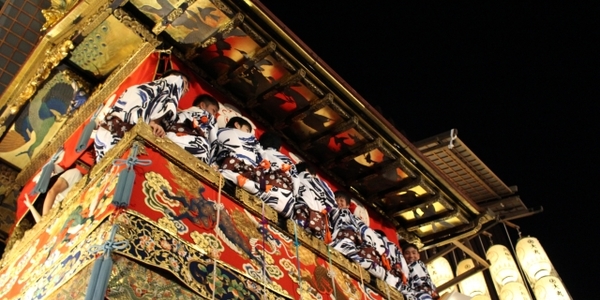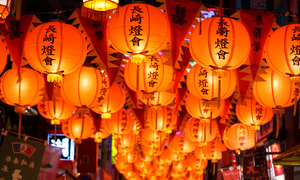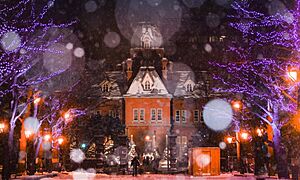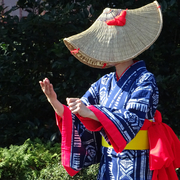Gion Matsuri Festival in Kyoto is well known for “Kon-Chiki-Chin”, its high-pitched festival music, and gorgeous decorative “Yamahoko (a float)” parade.
This is a summer festival, which fills a popular town of Kyoto among tourists with more people.
Especially, the event of Yamahoko is registered as UNESCO’s intangible cultural heritage, which attracts hundreds of thousand visitors every year.
While its gorgeousness, surprisingly, Gion Matsuri Festival began with the tragedic event.
Gion Matsuri is the festival of Yasaka Shrine located in Gion, Kyoto.
The name of Yasaka Shrine has used since the beginning of Meiji period(1868-1912).
There are many theories about its beginning, but it is said to have the origin that Fujiwara no Mototsune donated his own house to build a temple to calm the spirit of Sugawara no Michizane, who is enshrined deity of Kitano-tenmangu Shirine, in the Heian period(794-1185).

Then, since his act resembles the story of the temple called Gion-shoja donated to Buddha in India, this area came to be called “Gion”.
The religious service conducted in this area, called “Gion Goryo-e”, is the beginning of Gion Matsuri Festival.
“Goryo/Mitama” is spirits, which are of those who died by violence at unintended accidents or died with grudge to haunt the living by causing plagues.
In the Heian period(794-1185), religious services called “Goryo-e” were conducted to calm those spirits to change them to gods protecting the living from plagues in many areas in the capital of Kyoto.
In those days, in Kyoto, many people died of plagues, which led to a theory that it was caused from curses of foreign god “Gozutenno”.
“Gion Goryo-e” was conducted to deify Gozutenno to console its anger, which was the very beginning of Gion Matsuri Festival.
Festivals with Syncretism of Shinto and Buddhism
Gozutenno was originally a god protecting Indian temples, but, since it was very malignant, Japanese people interpreted as the same god as Susanoomikoto*, which was also malignant appearing in the Japanese myth.
*Susanoomikoto: the brother of Amaterasu-Ominokami of Ise-jingu Shrine, who is famous for killing off Yamata no orochi (eight-forked snake)
Thus, the interpretation of originally different two gods—one is from Japanese native myth and the other is from Buddhism of india as the same is called the syncretism of Japanese Shinto and Buddhism, which had various foreign gods combined with Japanese ancient gods until the ordinance distinguishing Shinto and Buddhism in the Meiji period(1868-1912).
Then, Gozutenno was interpreted as the same as “Muto-tenjin*”, who is an Indian god, which brought historical events related to Gion Matsuri Festival.
*Muto-tenjin; the god of northern sea, who called itself “I am Susanonokami” when visiting at southern sea to find a bride, which led to the interpretation to identify with Susanoo (named as Tatehaya-Susanono mikoto in “Kojiki (The Records of Ancient Matters)”.
Muto-tenjin was rejected by the rich when it asked for a stay over night on the journey, but later, “Sominshorai” was willing to hospitalize Muto-tenjin despite his poverty.
Muto-tenjin was so impressed that it told his family that they should call themselves as descendants of Sominshorai and wear “Chinowa” on waist.
Eventually, the plagues raged there, but the family of Sominshorai and its descendants were saved from any misfortunes and disasters to prosper for long.
From this historical event, there is a personal amulet with a tag written “Sominsyorai Shison Nari (I am the descendant of Sominshorai)” among Gion Matsuri Festival amulets.
Its shape is like Chimaki (a rice dumpling wrapped in bamboo leaves), which wishes for avoiding any misfortunes and disasters like Sominshorai.
The origin of this led to India.
From Hinduism in India to Shinto in Japan.
Moreover, some Yamahoko parade with the recitation of sutras by monks and carry Buddha, which shows Gion Matsuri Festival harmonizes various gods of different religions.
Yamahoko Parade as Moving Museum
Gion Matsuri Festival is held every July for a month, which is highlighted with Mikoshi Togyo (parade of Mikoshi (portable shrines), and monks for the divine spirits in the portable shrine moving to other places from the main shrine) and Yamahoko Junko (parade of Yamahoko floats).
The beauty of Yamahoko Junko is the most famous event among the festival.
Yamahoko decorated with excellent works which are displayed at museum, has each story and is highly valued as a fine and luxurious artwork.
For example, Tsukihoko (float associated with Tsukiyomi, deity of Moon) has the brush painting by Maruyama Oukyo, the painter representing early modern paintings, and secretly has carving of rabbits by Hidari Jingoro, the legendary sculptor in the Edo period(1603-1867).
Also, the tapestry* of the Mughal dynasty in India is draped, which creates unique atmosphere beyond countries and times.
*Tapestry: a type of textile for interior decoration, which is used for wall drapes and so on.

In addition, Kankohoko float is created from the ancient event that Mo Shokun of Qi in China made the checkpoint called Kanko in Henan of China open midnight by making his retainer imitate a cock when he fled from his own country under risks his life, which has the very unique design combining two different religions.
With the Gobelin tapestry inspired by the Old Testament at the front, and the letters quoted from the writing of Kobo-daishi at the back of the float, different types of artworks are beautifully harmonized as one.
We cannot help bowing to high sensitivities of creators, but Yamahoko makers have been from the local areas in Kyoto since the old time.
Yamahoko seems to be the main event of Gion Matsuri Festival, but in actuality, it began in the Nanbokucho period(1336-1392), a few hundred years later from Mikoshi Togyo.
At first, it was not that gorgeous, but in the Muromachi period(1336-1573), there had been no parade of Mikoshi (portable shrine) for a while, which made townspeople have more passions to Yamahoko to develop it to a beautiful Yamahoko admired as “moving museum”.
Festival with Japanese Generosity
Hinduism, Buddhism and Shinto.
The festival with various religions including Islam and Christianity on Yamahoko decoration can happen only in Japan, which has no religious wars.
Also, Yamahoko, which became gorgeous time by time, has taken in a wide range of beautiful works from each time beyond religious differences and has also preserved its history in it.
For example, the tree at the center of Yamahoko works as Yorishiro possessed by gods who cause plagues, meaning that this tree sends the gods far away.
The nature of Gion Matsuri Festival, begun to send Gozutenno, the god causing plagues, has been succeeded to the present.
As Japanese has taken in merits of various religions based on Shinto, Gion Matsuri Festival has preserved its tradition taking in the new, shows the generosity of Japanese.
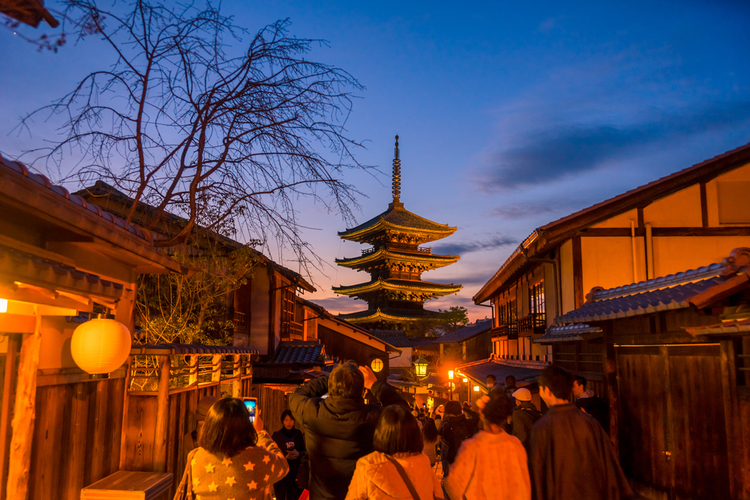
The above details are the only part of Gion Matsuri Festival.
Gion Matsuri Festival is the long festival held throughout every July with various religious services and events, not only having the religious and artistic essences.
Mikoshi Togyo is held at Shinko-sai on 17th and Kanko-sai on 24th like Yamahoko Junko, and lighten visitors and townspeople up with Komagata Chochin (lantern) at each Yoiyama (the eve of the main festival).
Those events have unique atmosphere and are well known, but there is Byobu Matsuri Festival (folding screen festival) to entertain the visitors by folding screens and tools secretly kept in the private houses and shops, as the part of Ato-Matsuri.
Compared with Yamahoko as “moving museum”, this event is called as “silent museum”, which also has certain atmosphere.
Moreover, at Saki-Matsuri, there are street stalls open on Yoi-Yoiyama (two days before the main festival) and Yoiyama.
The main street, where cars pass normally, turns to pedestrian-only area and has goldfish scooping and food stalls typical for festivals, which amuses around one million people every year.
In addition, restaurants and food shops along the street open their stalls to sell limited items for Gion Matsuri Festival, which you can also enjoy.
History, culture and food.
Gion Matsuri is the festival you can fully enjoy in various ways.

